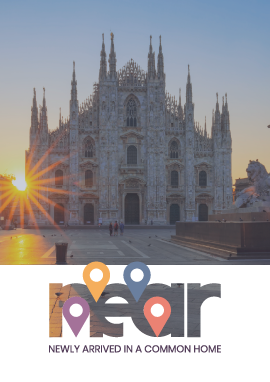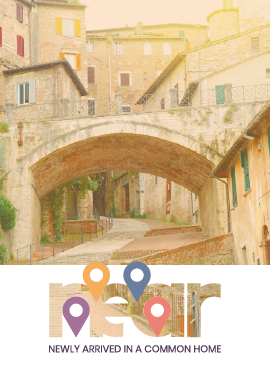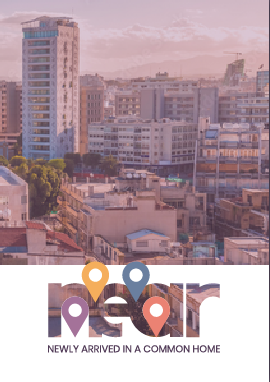The NEAR project aims to foster social orientation of migrants in the initial period of arrival and settlement in the local communities of destination. Diaspora stakeholders are some of the actors that the project empowers to act a Community Agents for newly arrived migrants. Part of the work done by NEAR is specifically aimed at providing these actors with the right knowledge and network to convey quick, context-specific and ready-to-use information and support through thematic trainings.
With this in mind, between March and December 2021 NEAR partners developed and implemented a number of activities directly addressed to diaspora members the four target cities, Milan and Perugia (Italy), Lisbon (Portugal) and Nicosia (Cyprus). The practice developed was eventually modelled into a number of tools under the NEAR National Stakeholder Reports, a set of publications taking stock of a year-long outreach, training and engagement of diaspora stakeholders. In doing so, they aim to facilitate the transfer of experiences, tools, knowledge and practices for organizations, practitioners and other interested groups to build the capacity of and empower diaspora communities as actors in the integration of newly arrived migrants at local level.
The reports follow the steps undertaken in the project, offering practical suggestions, templates and checklists along on how to:
- take into account diaspora communities in selecting target areas
- reach out to and engage diaspora communities preliminarily
- identify needs and select the right stakeholders for projects and initiatives
- organise content for training programmes
- use the most appropriate training methods and tools
- engage with community agents in a sustained way
- co-create communication campaigns and tools with community agents to best target newly arrived migrants
The report on Milan highlights the distinctive traits and lessons learnt that characterised the NEAR implementation in Northern Italy by ISMU and that could be transferred in new integration contexts.
To identify the right stakeholders and area, for instance, ISMU combined different data sets. It looked at the number of foreign citizens registered in the Milan’s administrative districts and, at the same time, mapped existing private social institutions, public offices and local institutions, volunteer and local organisations, diaspora organisations, reception centres for asylum seekers and refugees, schools and informal local groups. This step was key to identifying and building a network of stakeholders in the area that were actively supporting those coming to a new city.
In selecting key diaspora stakeholders to involve directly, ISMU targeted people that were deemed as very active and as playing a key role in their migrant community due to their personality, personal interests and professional background related to integration. The gender dimension was strongly considered in selecting diaspora stakeholders as it is a key variable for migrant reception and orientation to local services. Once ISMU identified people with key roles in their communities, it created informal opportunities (info sessions, informal talks) to get to know them better and brief them on the project to maximise participation. These events were also key to identifying the most pressing knowledge gaps and needs and structure training content and tools accordingly.
The training designed under NEAR addressed immigration and visa policy and access to basic services (work, housing, education and training, and healthcare), leveraging the expertise officials working for public services and/or in the non-profit sector. This allowed community agents not only to get legal/policy updates, feedback and answers to concrete problems by trainers who usually deal with them in their daily work, but also to visit the offices of some service providers, learn about their daily practice and expand their social network. In other terms, ISMU did not want simply to provide individual CAs with updates but also wanted to build the capacity of CAs as a group to act as new, cross-cutting support actors within migrant communities. For this reason ISMU always prioritised meetings that could be in-person and using group work methods.
The final training module included a guided tour of the target district, with stops in most significant places, allowing community agents to see familiar areas under a new light while also discovering new ones through history and anecdotes that took them into the “soul” of the district. This work ended with the systematisation of information and suggestions collected during the tour, including the more "emotional" experiences community agents had as migrants in a new city. The collaborative and interactive approach helped create an unconventional map of the neighborhood that brought together emotions, beloved places, difficulties and contradictions related to the personal experience community agents had of the city. In this activity the flow of emotions was stimulated both by personal stories and by means of music associated to the places and experiences.
The community agents said the whole training was very useful for their daily activities and on several occasions expressed the immediate applicability of the knowledge and insights acquired. For example, during the module on housing, a policy update on a more inclusive regional directive establishing the requirements for accessing public housing was immediately disseminated by some agents who were catering to some families looking for a home. Likewise, the session on the education for adults provided key information on the courses promoted by public institutions not only in the target neighborhood but also at the city level that agents quickly disseminated among fellow nationals who were looking for free or affordable training opportunities.









